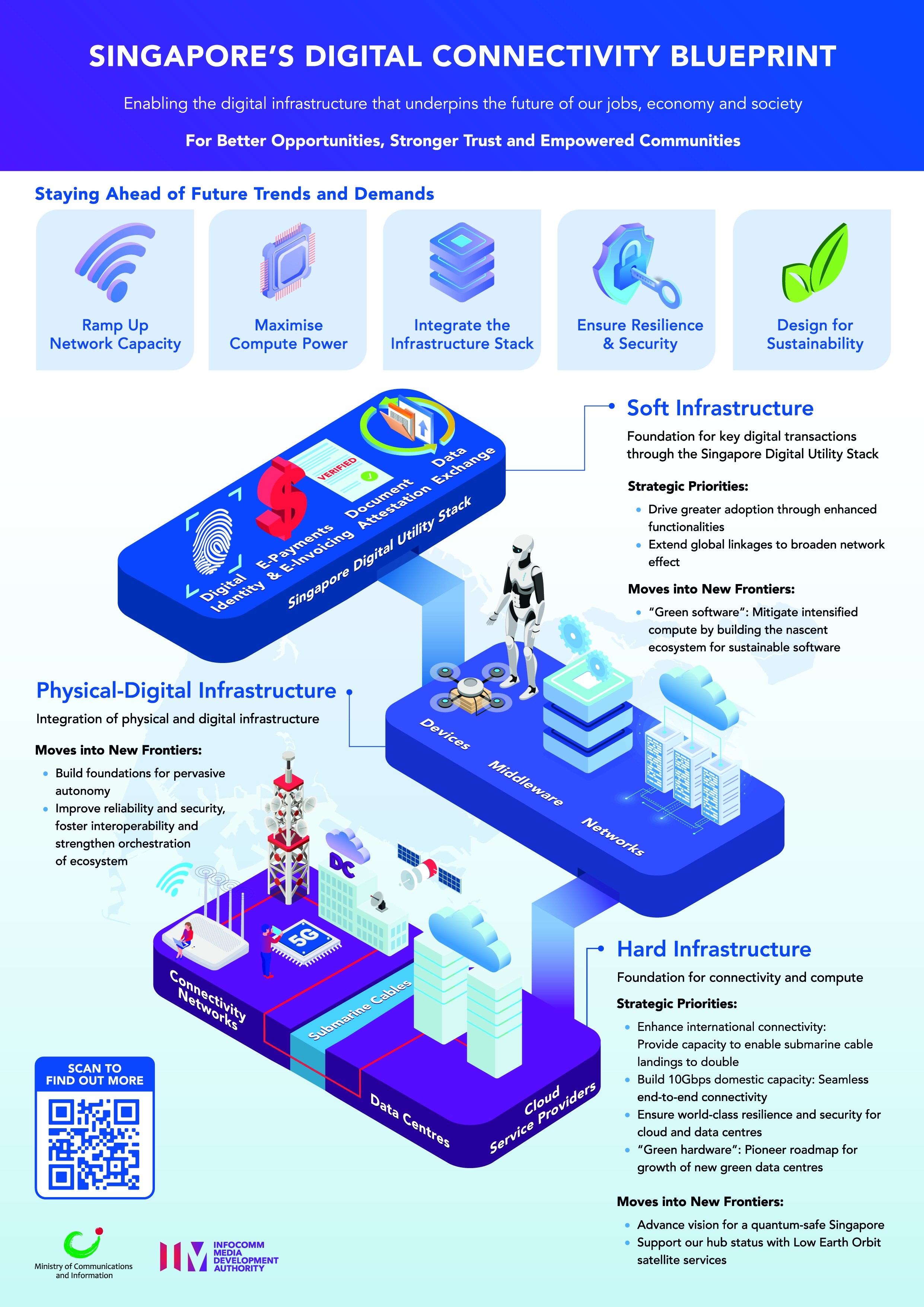Digital Infrastructure
The Foundational Role of Digital Infrastructure
Digital infrastructure – the submarine cables laid across ocean floors, satellites in space, optical fibre cables laid underground, mobile base stations on rooftops – is often unseen. Yet, it is the ‘invisible foundation’ upon which our digital economy and digital society are built. It undergirds our people’s access to digital services and interactions on digital platforms, and enterprises’ ability to transform their operations to drive greater productivity and growth.
MDDI’s Approach to Building Digital Infrastructure
MDDI’s approach toward building Singapore’s digital infrastructure centres
on three core tenets.
1. Making forward-looking investments – investing ahead
of demand so that Singapore is ready to embrace opportunities when technological
trends (e.g., Artificial Intelligence, autonomous systems, immersive experiences,
distributed cloud, quantum technologies) mature, and has the capacity to
deal with unexpected challenges (e.g., the surge in digital interactions
during a pandemic).
2. Taking a holistic view of the digital infrastructure stack –looking
beyond traditional connectivity to plan for the entire ‘digital infrastructure
stack’ in an integrated manner:
(a) Hard infrastructure – traditional submarine cable,
satellite, broadband, mobile and Wi-Fi networks, as well as Data Centres
(DCs) and cloud computing;
(b) Physical-Digital infrastructure – devices, middleware,
and networks that enable greater interaction between different digital
infrastructure components and their integration with the physical world;
and
(c) Soft infrastructure – the Singapore Digital Utility
Stack, comprising the foundation for key digital transactions to be conducted
seamlessly and securely, upon which businesses can build innovative platforms
and applications.
3. Playing to Singapore’s unique circumstances – while
being a small dense, city-state brings with it resource limitations (e.g.
carbon, land, spectrum) in digital infrastructure development, it presents
opportunities to drive innovation to overcome these constraints and serve
as a useful model for other urban cities. It also allows us to achieve
widespread domestic connectivity more easily and bring together different
ecosystem players to drive innovation and enhancements to our digital infrastructure.
Our Strategic Priorities and Moves into New Frontiers
As part of Singapore’s Digital Connectivity Blueprint launched in June 2023, MDDI has set out five strategic priorities to enhance our digital infrastructure and stay ahead of future trends and demand:
1. Provide capacity to enable submarine cable landings to double within
the next 10 years;
2. Build seamless end-to-end 10 Gbps domestic connectivity within the
next five years;
3. Ensure world-class resilience and security of increasingly critical
compute infrastructure;
4. Pioneer a roadmap for the growth of new green DCs and push the sustainability
envelope (Note: IMDA has since launched the Green DC Roadmap in
June 2024); and
5. Drive greater adoption of the Singapore Digital Utility Stack, to expand
the benefits of seamless digital transactions.
We will also make moves in more nascent, frontier areas to reap future opportunities.
MDDI will work with stakeholders in the public and private sectors to take these plans and ambitions forward. Ultimately, they are aimed at:
1. Enhancing opportunities for our enterprises and people;
2. Strengthening trust to participate in the digital economy and society
confidently; and
3. Empowering communities to connect and improve lives.

Ensuring an Effective and Conducive Regulatory Environment
Regulatory measures are one of the levers MDDI employs to strengthen the resilience and robustness of our digital infrastructure.
We regularly review them to ensure they keep pace with technological advancements, business models, and our people’s needs. Examples of such measures include IMDA’s Code of Practice for Telecom Service Resilience and Quality of Service standards.
As outlined in the Digital Connectivity Blueprint, we will also explore the need to regulate critical components of the expanding digital infrastructure stack in a calibrated, risk-based manner.

